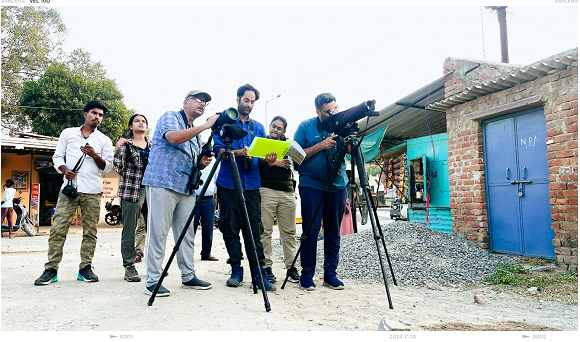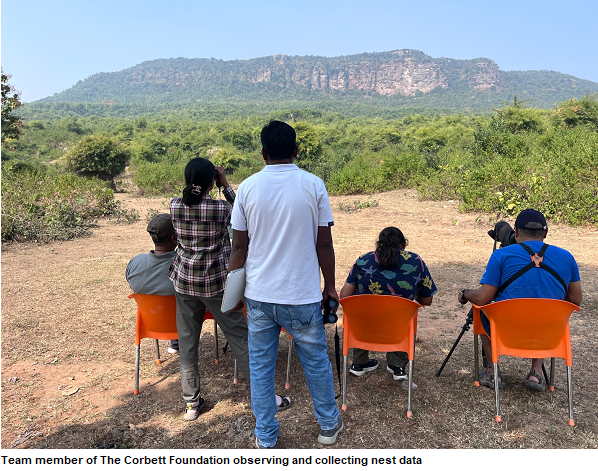The Vulture Chronicles: The shifting sands of Jukehi and Kymore
Munir Virani
At the crack of dawn, our vulture monitoring team departed the modest comfort of our Katni hotel, embarking on a journey through the rugged heart of Madhya Pradesh, in Central India. Our destination was Jukehi, a site just north of Katni, shadowed by the overwhelming presence of the ACC cement factory. Its kilns burned incessantly, shrouding the landscape in a mountain of smoke that seemed at odds with the pristine habitats we sought to protect. Our convoy split early; one vehicle veered off toward Bandhavgarh to address a sudden medical emergency, leaving the rest of us to navigate the dusty trails to our research sites. We were a band of excited vulture biologists, bound by a shared passion for conservation and tea, our equipment—telescopes, data sheets, cameras—packed and ready to capture the day’s critical data.

I was back at my old stomping grounds after a hiatus of eight years. Our goal was to establish the fate of critically endangered Long-billed Vultures. Following the catastrophic crash of vultures in south Asia since the mid 1990s, The Peregrine Fund sent me to south Asia as a young naïve biologist on a fact-finding mission to ascertain whether there was a role for them to play. That was back in March of 2000. Fast forward 24 years later, The Peregrine Fund solved the problem. We figured out that it was a non-steroidal anti-inflammatory drug called diclofenac that was being administered to livestock and when vultures fed on contaminated livestock carcasses, it caused kidney failure and subsequently death. As a result, south Asia lost nearly 99% of its vultures. In 2006, diclofenac was banned for veterinary use and my task was to meticulously design a study that showed how this affected vulture populations. Since 2003, we collected and built our data base of numbers of occupied nests of the critically endangered Long-billed Vultures that nest on cliffs. Now in my new role with the MBZ Raptor Conservation Fund, we are back in the heart of central India to investigate how the vultures were faring.

The journey resumed where we had paused the day before. We moved slowly, deliberately, stationing our vehicles in slivers of shade alongside the bustling roads. Despite the acrid air that sometimes made us wince, our focus remained steadfast on the cliffs—home to our subjects. At one stop, right in front of a chaiwalla’s humble shop, we were treated to steaming cups of ginger-infused karak chai (tea). It was a small, yet profound luxury amidst the arduous day, reminding us of the simpler pleasures of life.
Through the lens of my telescope, the sight of a short-toed eagle soaring into the blue expanse stirred a deep connection to this land—a reminder of its rich biodiversity and the resilience of its inhabitants. Each sip of tea felt like a pause in time, a moment to reflect on the journey, both personal and professional, that had brought me back to these cliffs after eight long years. India, around me, buzzed with a vibrant concoction of progress and tradition. Children, smartphones in hand, still broke away to play cricket in open fields. The cacophony of traffic, the animated conversations, the everyday chaos—it was all as familiar as it had been decades ago when I first counted nests on these very cliffs.
Today, our preliminary counts bore promising news. The number of occupied nests had grown, a testament to the commitment of conservationists working on the Asian Vulture Crisis, and the resilience of nature and the impact of our collective efforts to ban the veterinary use of diclofenac—a drug that had once threatened to erase South Asia’s vultures. Each new occupied nest, each sighting of roosting birds, added layers to our understanding and fueled a quiet optimism within us.
It was a full moon night – an apt ending to the day. As the sun set over the Khemur hills, our final counts at Jukehi and Kymore concluded, a sense of accomplishment washed over us. Our partnership with the Corbett Foundation promised a new chapter for this two-decade-long study, ensuring that the work would continue even as we moved on. The sun dipped below the horizon, casting a golden glow over the rugged terrain as we drove towards Tala, in the heart of Bandhavgarh Tiger Reserve. Here, in the sanctuary of wild tigers and ancient trees and monuments, our journey would find its closing notes—but the story of the vultures of Jukehi and Kymore, like the cliffs themselves, would endure, a lasting monument to conservation and hope.





Leave a reply